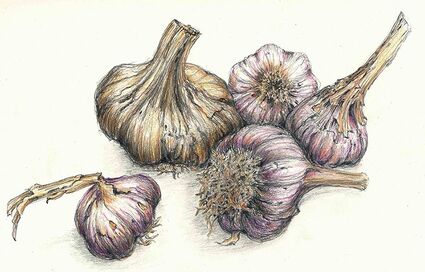Garlic: Several Varieties Thrive in SETX
Last updated 8/23/2022 at 2:05pm
There are nearly 600 cultivars of garlic cultivated world-wide with Central Asia cultivating 120 varieties (Image courtesy Pinterest).
Garlic offers several health benefits and is widely used in cooking as an herb, though technically it is a vegetable, a very pungent vegetable! Purchasing garlic, while convenient, doesn’t provide us the most flavorful experience possible. Commercially, garlic is held in cold storage before being placed into the produce section of our local markets, cold storage slows garlic’s aging process. Most of us cook with garlic, frequently, have you considered growing garlic?
True garlic (Allium sativum) is divided into two subspecies: softneck and hardneck. There are 11 different groups of garlic, three are classified under softneck. Softneck (Allium savitum var. savitum) garlic varieties grow in warm climates with mild winters. There are also hardneck garlic varieties which grow equally well here. Most softneck varieties do not produce scapes, which are slender bloom stalks, coiling downward resembling curly green beans, meaning less work not having to remove scapes. The three softneck varieties are: Silverskin, Artichoke and Middle Eastern.
Silverskin garlic cultivars have the longest shelf life of all garlic, a year or longer. Varieties include Mother of Pearl and French, which are earliest to harvest and Silverwhite and Nootka Rose being the last.
Artichoke garlic is named for overlapping clove configurations around the bulb. Cultivars are include California Early, California Late, Polish Red, and Italian Purple, to name a few.
Middle Eastern garlic tend to be stronger in flavor, more difficult to grow and are not readily available. Varieties include Syrian, Palestinian, and Belarus.
Hardneck garlic is divided into 8 groups: Porcelain, Rocambole, Purple Stripe, Glazed Purple Stripe, Marble Purple Stripe, Asiatic, Turban, and Creole. In cooler climates, USDA zones 2-6, hardneck garlic will produce scapes, which must be removed to maximize bulb size. There are two hardneck garlic groups (Allium savitum var. ophioscorodon) which grow well in SETX: Creole, and Asiatic.
Creole garlics are a silverskin subvariety which are sweet tasting and long lasting. The bulbs are plump, with purple-skinned cloves. Sometimes referred to as Mexican Purple garlic, varieties include Ajo Rojo, Creole Red, Cuban Purple, Burgundy, and Pescadero Red.
Asiatic garlics typically don’t form scapes in warm climates but if they appear, Asiatic garlic differs from other hardneck garlic in that the scapes can be left on the plants without affecting final bulb size. Easy to grow often maturing weeks ahead of most other garlic types. Varieties include Asian Tempest, Korean Red, Korean Mountain, Japanese, and Russian Redstreak.
Garden bed preparation is key to growing an abundance of garlic! Purchase organic garlic from a reputable online vendor, such as keeneorganics.com in Wisconsin (largest selection) or willhiteseed.com in Texas. There is a shipping delay, most vendors ship garlic September thru November but order now, before they sell out! Having purchased organic garlic from both vendors, they have good selections while offering excellent customer support. Once the mail order is received, place the garlic bulbs in the refrigerator for at least a month (in a paper rather than plastic bag). Garlic needs undergo vernalization, a “cold spell”. We, southern gardeners must create a “winter-like” environment for garlic. Take the opportunity while the garlic is undergoing vernalization to prepare the garden bed with soil amendments, to ensure a bountiful harvest.
Garlic is best planted in mid to late fall, between late October thru mid-December. Before planting garlic in a raised and work 2 to 3-inches aged manure, humus and 8-8-8 fertilizer (about 1 ½ cups per 10 linear feet) into the top 6 inches of soil. Allow the mixture to age 4 to 6 weeks before planting. The soil must be friable- loose, crumbly, and well drained.
Separate garlic bulbs into individual cloves, reserving the smallest for kitchen use. Plant cloves 2 inches deep, basal plate down (root end), spacing each clove 3 to 5 inches apart. Once all garlic cloves are planted, cover each clove lightly with soil. Add 2 to 3 inches of mulch over the entire bed, protection against winters cold temperatures. During winter months remove weeds from garlic beds, as they compete for soil nutrients.
When leaves first appear in spring, feed each plant 2 teaspoons of high nitrogen fertilizer that decomposes slowly; blood meal is a good choice. Work into the soil next to each plant. Add more mulch if necessary and continue removing weeds from beds.
When the leaves begin turning brown, the garlic is ready to harvest. Check when only 5-6 leaves remain green. Use a garden spade or fork to gently loosen the soil around the garlic before attempting to lift the bulbs. Pulling the plants from the soil without loosening the soil will damage the bulbs, causing them to rot during the curing process. Garlic must be cured before it can be stored. Bundle 6 to 10 plants by their leaves. Hang each bundle on a line in a shady area with plenty of air circulation for approximately three weeks.
Let’s go out and grow ourselves a greener, more sustainable world, one plant at a time!
If you have specific gardening questions or would like more information, contact the Orange County Master Gardeners Helpline: (409) 882-7010 or visit our website: https://txmg.org/orange, Facebook: Orange County Texas Master Gardeners Association or Email: [email protected].








Reader Comments(0)